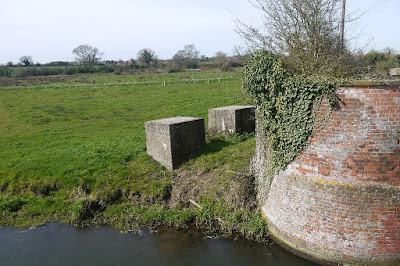A long weekend in Norfolk allowed for a bit
of pillbox hunting. On the way up, we took in some of the defences of stop line
FII, which uses the River Brue and the Broads as anti-tank obstacles (the
Broads has little in the way of concrete defences, defence instead relying
largely on the river patrols). However, crossings over the Brue between Wroxham
and Aylsham are defended by pillboxes and anti-tank cubes. We visited some of
the defences at Brampton, Burgh next Aylsham and Aylsham. This was a divisional
stop line – i.e. it was intended to delay or act as a deterrent to enemy armour
rather than halt it completely (corps stop lines and the GHQ stop line on the
other hand were intended to bring enemy armour to a halt).
The bridge over the Brue at Brampton has
the classic stop-line defences of anti-tank cubes and a mined bridge covered by
a type 22 pillbox. The anti-tank cubes are 5ft square and block the immediate
approach to the bridge from the sides; the two on opposite sides of the bridge
have iron rails set into them to take further rails to block the road. The
bridge would also have been prepared for demolition.
Above: View of the bridge at Brampton from one of the pillbox loopholes.
Above: The Type 22 pillbox at Brampton
Anti-tank blocks guarding the approach to the bridge from the flanks. Note the iron rails set into one of the cubes that would have taken a rail to block the bridge.
The anti-tank blocks on the other side of the bridge. A block (hidden in the ivy) has rails set into it as well to take the road blcok
One of the loopholes
The neat interior of the pillbox.
The pillbox, anti-tank cubes and bridge at Brampton
At Burgh next Aylsham, eight anti-tank
blocks also block the approach to the bridge from the sides, but there is no
pillbox defending the bridge.
Above: The anti-tank cubes at Burgh next Aylsham
Above: The Burgh next Aylsham War Memorial
Aylsham is a nodal point and was defended
by numerous pillboxes, of which at least three survive today. Of these, I was
interested in a pillbox built onto a wall of a water mill – apparently constructed
by the Ministry for Food to defend the water mill - and constructed by sandbags
filled with cement. The most recent information on the internet suggested
concern for the future of this pillbox as planning permission had been given
for conversion of the old water mill into residential flats. I am glad to say that
the pillbox is still extant.
Above: The pillbox constructed from sandbags on the end of a wall of the water mill at Aylsham.












Comments
Post a Comment